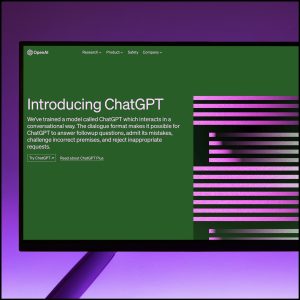Introduction: In today’s digital age, students have access to a wide range of resources to aid their learning process. One such powerful tool is the Large Language Model (LLM), which can greatly assist students in understanding and retaining their course material. LLMs, like the impressive GPT-3.5, can serve as intelligent virtual tutors, offering valuable insights, explanations, and prompts to enhance a student’s learning experience. Here we explore how LLMs can be leveraged effectively by students and highlight some best practices and helpful prompts to maximize their educational benefits.Understanding the Role of LLMs in Learning:LLMs are trained on a vast amount of text data, enabling them to comprehend and generate human-like responses. By utilizing LLMs, students can tap into a wealth of knowledge and receive tailored assistance for their specific learning needs. Here are some ways in which LLMs can support the learning process:
In today’s digital age, students have access to a wide range of resources to aid their learning process. One such powerful tool is the Large Language Model (LLM), which can greatly assist students in understanding and retaining their course material. LLMs, like the impressive GPT-3.5, can serve as intelligent virtual tutors, offering valuable insights, explanations, and prompts to enhance a student’s learning experience. Here we explore how LLMs can be leveraged effectively by students and highlight some best practices and helpful prompts to maximize their educational benefits.Understanding the Role of LLMs in Learning:LLMs are trained on a vast amount of text data, enabling them to comprehend and generate human-like responses. By utilizing LLMs, students can tap into a wealth of knowledge and receive tailored assistance for their specific learning needs. Here are some ways in which LLMs can support the learning process: 1. Concept Explanation and Clarification:LLMs can provide clear and concise explanations for complex concepts or topics. When faced with challenging course material, students can use prompts such as, “Can you explain the concept of X in simple terms?” or “What are the key components of Y?” to receive detailed and understandable explanations from the language model. This feature is particularly useful when textbooks or lectures fail to address specific points or when students require additional clarification.2. Problem Solving and Practice:LLMs can act as virtual problem-solving partners. Students can present questions or problem statements to the language model, and it can guide them through the step-by-step process of finding solutions. For example, a prompt like, “Can you help me solve this calculus problem?” or “What is the most efficient approach to tackle this programming challenge?” can yield insightful responses that aid in understanding and sharpening problem-solving skills.3. Generating Study Materials:LLMs can assist students in creating study materials such as summaries, flashcards, or essay outlines. By providing prompts like, “Can you help me summarize the main points of this chapter?” or “Please generate an outline for an essay on topic Z,” the language model can generate coherent and structured responses. These materials can serve as valuable study aids, reinforcing key concepts and facilitating efficient review sessions.4. Literature Review and Research Assistance:For students working on research papers or literature reviews, LLMs can offer tremendous support. By providing specific prompts related to their research topic, students can receive relevant sources, summaries, or even generate ideas for their writing. For example, a prompt like, “Please provide me with recent studies on the impact of climate change on agriculture” can yield a list of references, abstracts, and key findings, saving students significant time and effort.Best Practices for Leveraging LLMs Effectively:
1. Concept Explanation and Clarification:LLMs can provide clear and concise explanations for complex concepts or topics. When faced with challenging course material, students can use prompts such as, “Can you explain the concept of X in simple terms?” or “What are the key components of Y?” to receive detailed and understandable explanations from the language model. This feature is particularly useful when textbooks or lectures fail to address specific points or when students require additional clarification.2. Problem Solving and Practice:LLMs can act as virtual problem-solving partners. Students can present questions or problem statements to the language model, and it can guide them through the step-by-step process of finding solutions. For example, a prompt like, “Can you help me solve this calculus problem?” or “What is the most efficient approach to tackle this programming challenge?” can yield insightful responses that aid in understanding and sharpening problem-solving skills.3. Generating Study Materials:LLMs can assist students in creating study materials such as summaries, flashcards, or essay outlines. By providing prompts like, “Can you help me summarize the main points of this chapter?” or “Please generate an outline for an essay on topic Z,” the language model can generate coherent and structured responses. These materials can serve as valuable study aids, reinforcing key concepts and facilitating efficient review sessions.4. Literature Review and Research Assistance:For students working on research papers or literature reviews, LLMs can offer tremendous support. By providing specific prompts related to their research topic, students can receive relevant sources, summaries, or even generate ideas for their writing. For example, a prompt like, “Please provide me with recent studies on the impact of climate change on agriculture” can yield a list of references, abstracts, and key findings, saving students significant time and effort.Best Practices for Leveraging LLMs Effectively: To maximize the benefits of using LLMs for learning, it is important to follow some best practices. Consider the following tips:1. Be Specific and Clear:When formulating prompts, ensure that they are precise and unambiguous. Clearly state the objective or the information you seek. This helps the language model provide focused and relevant responses.2. Engage in a Dialogue:Instead of relying solely on one-time queries, consider engaging in a back-and-forth dialogue with the LLM. This iterative process can provide deeper insights and foster a better understanding of the subject matter.3. Verify and Cross-reference Information:While LLMs offer a wealth of information, it is essential to verify the accuracy and reliability of the responses. Cross-reference the generated content with trusted sources to ensure the information is correct.4. Maintain Active Learning:While LLMs can be incredibly helpful, they should not replace active learning practices. Engage with course materials, participate in discussions, and attempt problem-solving independently. LLMs should serve as supplements to your learning journey, not substitutes.Helpful Prompts for LLM Interaction:To facilitate effective interaction with LLMs, consider using the following prompts:
To maximize the benefits of using LLMs for learning, it is important to follow some best practices. Consider the following tips:1. Be Specific and Clear:When formulating prompts, ensure that they are precise and unambiguous. Clearly state the objective or the information you seek. This helps the language model provide focused and relevant responses.2. Engage in a Dialogue:Instead of relying solely on one-time queries, consider engaging in a back-and-forth dialogue with the LLM. This iterative process can provide deeper insights and foster a better understanding of the subject matter.3. Verify and Cross-reference Information:While LLMs offer a wealth of information, it is essential to verify the accuracy and reliability of the responses. Cross-reference the generated content with trusted sources to ensure the information is correct.4. Maintain Active Learning:While LLMs can be incredibly helpful, they should not replace active learning practices. Engage with course materials, participate in discussions, and attempt problem-solving independently. LLMs should serve as supplements to your learning journey, not substitutes.Helpful Prompts for LLM Interaction:To facilitate effective interaction with LLMs, consider using the following prompts: 1. “Can you provide a concise summary of [topic]?”2. “What are the main differences between [concept A] and [concept B]?”3. “Please explain [term/theorem/principle] in simple terms.”4. “How can I apply [theory/concept] to solve [specific problem]?”5. “What are the most significant studies or research papers on [topic]?”6. “Can you help me create an outline for an essay on [subject]?”7. “What are the key steps to [process/activity]?”8. “What are the advantages and disadvantages of [technology/methodology]?”Conclusion:Large Language Models have revolutionized the way students can learn and interact with course materials. By leveraging the power of LLMs like GPT-3.5, students can access personalized support, explanations, and study aids that enhance their learning journey. By following best practices and utilizing helpful prompts, students can effectively integrate LLMs into their study routine, improving their understanding and retention of course material. Remember, while LLMs are invaluable resources, they should be used alongside active learning practices to foster a well-rounded and comprehensive educational experience.
1. “Can you provide a concise summary of [topic]?”2. “What are the main differences between [concept A] and [concept B]?”3. “Please explain [term/theorem/principle] in simple terms.”4. “How can I apply [theory/concept] to solve [specific problem]?”5. “What are the most significant studies or research papers on [topic]?”6. “Can you help me create an outline for an essay on [subject]?”7. “What are the key steps to [process/activity]?”8. “What are the advantages and disadvantages of [technology/methodology]?”Conclusion:Large Language Models have revolutionized the way students can learn and interact with course materials. By leveraging the power of LLMs like GPT-3.5, students can access personalized support, explanations, and study aids that enhance their learning journey. By following best practices and utilizing helpful prompts, students can effectively integrate LLMs into their study routine, improving their understanding and retention of course material. Remember, while LLMs are invaluable resources, they should be used alongside active learning practices to foster a well-rounded and comprehensive educational experience.

